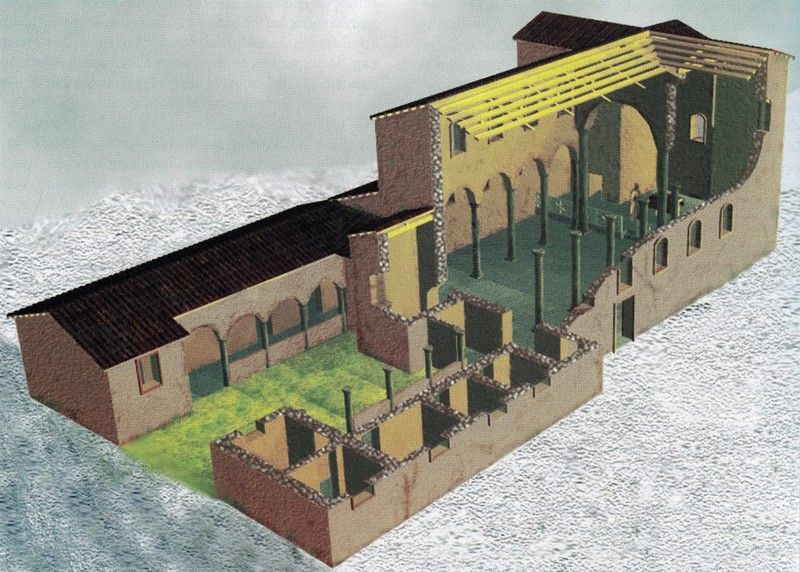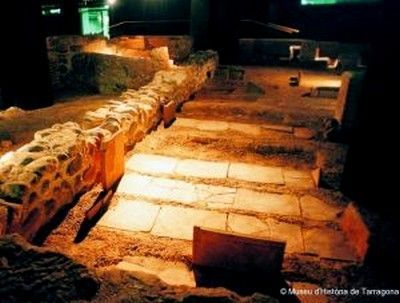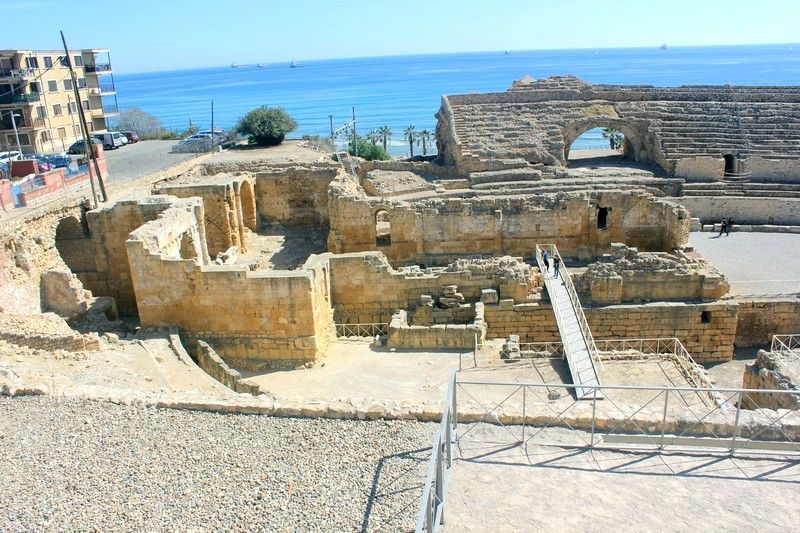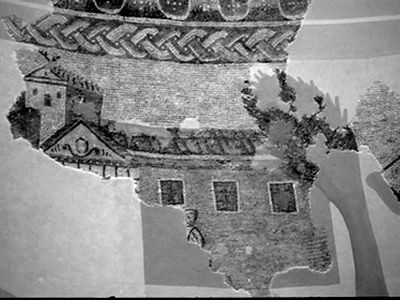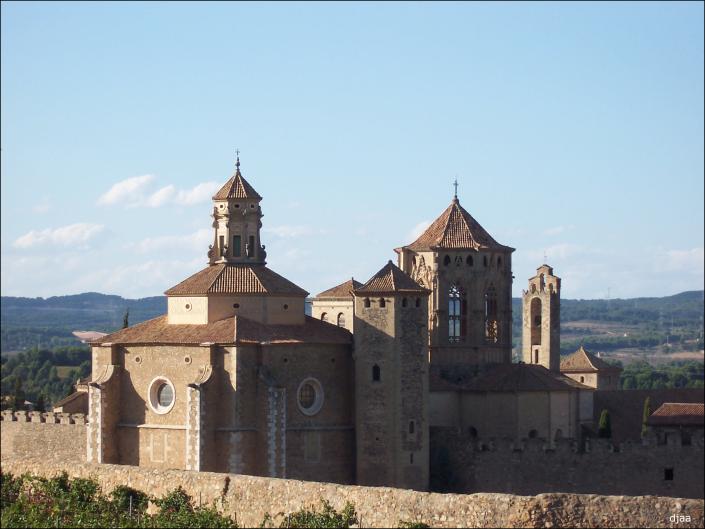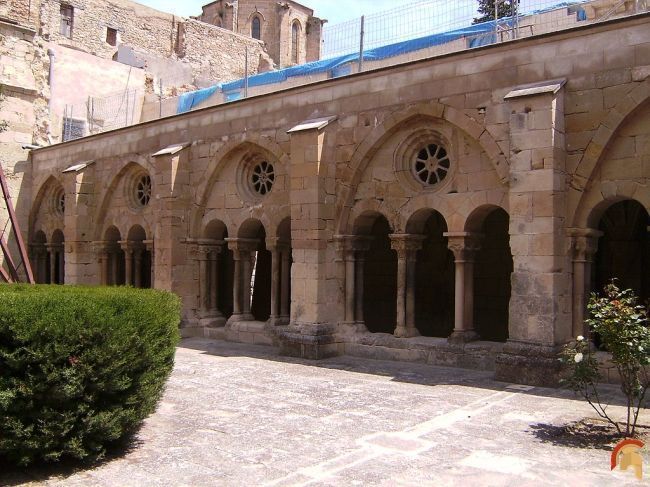NECRÓPOLIS PALEOCRISTIANA Y BASÍLICA DE SAN FRUCTUOSO

Historic environment
Located in the south-west suburb of the Roman city and on the grounds of the old Tobacco Factory, the discovery (1923) and excavation of the Paleochristian necropolis of Tarragona at the beginning of the 20th century was undoubtedly one of the most important discoveries. significant in the history of research devoted to early Christianity in the Western Roman Empire. Only the remains of the paleochristian necropolis of Carthago occupy a larger area than those of Tarraco.
The importance of the site within the universe of Hispanic Christian archeology lies not only in the necropolis itself, but also in the identification of a funerary basilica related to the cult of the martyr Fructuoso and his deacons Augurio and Eulogio, local martyrs who found death in the year 259 in the city amphitheater through the crematio.
As a generating seed of this necropolis, we can consider the presence of a memory in which the ––o  some of the–– relics of the Tarragona martyrs, with a chronology of use accepted by archeology that would oscillate between the 3rd/4th and 6th centuries, and with a notable decline from the end of the 5th century, since burials stopped taking place at the beginning of the 6th century. It would not be strange if the survival of the basilica, now without new burials, lasted until the city was taken by the Muslims, as several authors have defended. However, perhaps this funerary decline should be related to the transfer of the relics to the new basilica of the amphitheatre, dated precisely from the second half of the 6th century––, and from where it would be easier to evacuate the precious relics to the inside the city in case of danger or outside attack. In any case, the floods to which the necropolis (located in the vicinity of the Francolí River) was subjected would end up paying it off. On the other hand, the evolution of archaeological research has been demonstrating the close relationship that this basilica presents with another nearby basilica, the one located in the northern sector of the Francolí River and known as the ‘Basilica of the Central Park’, which we analyze in another file.
some of the–– relics of the Tarragona martyrs, with a chronology of use accepted by archeology that would oscillate between the 3rd/4th and 6th centuries, and with a notable decline from the end of the 5th century, since burials stopped taking place at the beginning of the 6th century. It would not be strange if the survival of the basilica, now without new burials, lasted until the city was taken by the Muslims, as several authors have defended. However, perhaps this funerary decline should be related to the transfer of the relics to the new basilica of the amphitheatre, dated precisely from the second half of the 6th century––, and from where it would be easier to evacuate the precious relics to the inside the city in case of danger or outside attack. In any case, the floods to which the necropolis (located in the vicinity of the Francolí River) was subjected would end up paying it off. On the other hand, the evolution of archaeological research has been demonstrating the close relationship that this basilica presents with another nearby basilica, the one located in the northern sector of the Francolí River and known as the ‘Basilica of the Central Park’, which we analyze in another file.
Currently, part of the necropolis and the construction remains associated with an important Christian place of worship can be visited and extend around the aforementioned building of the old Tobacco Factory. A small interpretation center highlights the history of the place and the most outstanding finds, and it exhibits some of the original early Christian sarcophagi.
Description
Made up of more than 2,000 burial sites, the sprawling Christian necropolis, partly built on an earlier pagan necropolis, functioned until at least the early 6th century, expanding adsanctos > Around the relics of the Tarragona martyrs. It is a unique cemetery, with a variety of types of loculi (slab tombs, tegulae , amphora, etc.). The set includes the presence of crypts, as well as richly decorated imported sarcophagi.
The remains of the basilica correspond, basically, to the foundation of the chancel and to fragments of the north wall of the building, being able to identify a temple facing east, with three naves separated by columns and a semicircular apse with a possible sacrarium</ i>. The interior length of the building ranges between 38 and 39 m, and the width between 18’5 and 19 m, the  Roman foot the measure used. A wall was also excavated on the west side, which J. Serra Vilaró interpreted as a possible atrium or narthex, a solution that current research seems to rule out. Most of these walls, painted with bands of different colors, were of fragile consistency, built with pebbles and mud. Part of the paving of the complex was mosaic, initially dating from the middle of the 4th century. However, as another opus signinum pavement was documented below ––the one containing the tombstones dated up to the early years of the 6th century––, the mosaic pavement must necessarily be located from now on. On the other hand, in a lateral chamber located to the south of the apse there is a structure that J. Serra Vilaró considered a baptismal pool, an interpretation that is currently discussed by some authors and accepted by others. It has also been proposed that the so-called mausoleum no. 17 corresponds, in reality, to a contraapse of the church that would contain a main tomb. J. López has also pointed out that the basilica would have, on its south side, a courtyard enclosed by walls and a monumental access. The researcher points out the possibility that these buildings, located to the south of the basilica, correspond to the monastery founded by Bishop Sergio, he even raises the possibility that there was a hostel for pilgrims in the place.
Roman foot the measure used. A wall was also excavated on the west side, which J. Serra Vilaró interpreted as a possible atrium or narthex, a solution that current research seems to rule out. Most of these walls, painted with bands of different colors, were of fragile consistency, built with pebbles and mud. Part of the paving of the complex was mosaic, initially dating from the middle of the 4th century. However, as another opus signinum pavement was documented below ––the one containing the tombstones dated up to the early years of the 6th century––, the mosaic pavement must necessarily be located from now on. On the other hand, in a lateral chamber located to the south of the apse there is a structure that J. Serra Vilaró considered a baptismal pool, an interpretation that is currently discussed by some authors and accepted by others. It has also been proposed that the so-called mausoleum no. 17 corresponds, in reality, to a contraapse of the church that would contain a main tomb. J. López has also pointed out that the basilica would have, on its south side, a courtyard enclosed by walls and a monumental access. The researcher points out the possibility that these buildings, located to the south of the basilica, correspond to the monastery founded by Bishop Sergio, he even raises the possibility that there was a hostel for pilgrims in the place.
The epigraphic testimonies clearly support the existence of a temple associated with the relics of the martyrs of the amphitheatre. This is the case with inscription no. 321 of the J. Vives catalogue, and in which the fragmented name of Bishop Fructuoso appears, followed by the letter «A» ––CTVOSI A––. The text has been restored by adding the names of the two deacons ––Augurio and Eulogio–– who accompanied Fructuoso during his martyrdom. It is interesting to note that this epigraph makes an angle at the top with a molded face, with signs of wear due to friction that seem to indicate that we are before a fragment of an altar, dome or transenna.</i > The ad sanctos essence of this cemetery is reinforced by another funerary inscription collected in ICERV 209, where the formula in sedes sanctorum</ i>. The inscription 294, sancta Christi sedes, belonging to the tombstone of a certain Optimus, would reinforce the idea that we are before a building consecrated to God.
On an artistic level, the recovered sarcophagi and massive funerary laudas constitute one of the most notable ensembles of Christian Hispania under the imperial period, and some of them can be visited in situ. On the other hand, among the very few objects recovered inside Christian tombs, an articulated ivory doll stands out, which is one of the most emblematic pieces of Tarragona archaeology.
Jordina Sales-Carbonell for URBS REGIA
Other interesting information
| Visiting hours and conditions
January, February, November and December: Weekdays from 9:30 a.m. to 1:30 p.m. and from 3:00 p.m. to 5:30 p.m. // Holidays from 10 a.m. to 2 p.m. March, April, May and October: Weekdays from 9:30 a.m. to 1:30 p.m. and from 3:00 p.m. to 6:00 p.m. // Holidays from 10 a.m. to 2 p.m. June, July, August and September: Weekdays from 10:00 a.m. to 1:30 p.m. and from 4:00 p.m. to 8:00 p.m. // Holidays from 10 a.m. to 2 p.m. |
Bibliography
-Serra Vilaró, J., 1929: Excavaciones en la necrópolis romano-cristiana de Tarragona, Ed. Tipografía de la Revista de Archivos, Madrid.
-Serra Vilaró, J., 1948: La necrópolis de San Fructuoso, Arzobispado de Tarragona, Tarragona.
-Del Amo Guinovart, M. D., 1979-89: Estudio crítico de la necrópolis paleocristiana de Tarragona, Tarragona, Excma. Diputació Provincial de Tarragona, Tarragona, 3 vols.
-López Vilar, J., 2006: Les basíliques paleocristianes del suburbi occidental de Tarraco. El temple septentrional i el complex martirial de Sant Fructuós, 2 vols. (Sèrie Documenta 4), Universitat Rovira i Virgili i Institut Català d’Arqueologia Clàssica, Tarragona.
-López Vilar, J., 2010: ”El santuari paleocristià dels sants màrtirs Fructuós, Auguri i Eulogi en el suburbi de Tàrraco”, Pau, Fructuós i el cristianisme primitiu a Tarragona (segles I-VIII), Fundació Privada Liber, Tarragona, 351-379.
-Sales Carbonell, J., 2012: “Basílica y Necrópolis Paleocristiana de Tarrraco”, Las Construcciones cristianas de la Tarraconensis durante la Antigüedad Tardía: Topografía, arqueología e historia, Edicions de la Universitat de Barcelona, Barcelona, 313-316.
Portals











